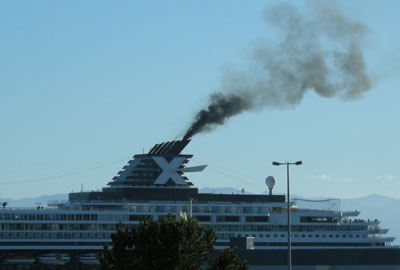Apr
27
By Josie Bannerman
The International Maritime Organization (IMO) reached a decision at a meeting in London England in late March to adopt a North American Emission Control Area (ECA) proposed by Canada and the United States.
The IMO is a United Nations agency responsible for global regulations to control pollution from ships. At present, the IMO says international shipping accounts for about 2.7% of world CO2 emissions from fossil fuel combustion.
The ECA covers the waters of Canada and the United States south of 60 degrees North out to 200 nautical miles. Large freighters, tankers and cruise ships operating within the ECA, regardless of the flags they fly, will be subject to new environmental standards that will reduce air pollution incrementally between 2012 and 2020.
Marg Gardiner, James Bay Neighbourhood Association (JBNA) director and member of the Quality of Life and Environment Committee said, "It's great that international standards are coming in. But standards are meaningless if there isn't an associated monitoring and enforcement program to go with it." The JBNA has been instrumental in monitoring the effects of air pollution from cruise ships in our community since 2006.
New ECA standards include use of cleaner fuel, improved design and propulsion technologies, and improved operational practices to reduce the main pollutants contained in ships exhaust gas - nitrous oxides, sulphur oxides and fine particulate matter.
Transport Canada will begin enforcing ECA standards August 1, 2012. A spokesperson for Transport Canada said Marine Safety Inspectors will verify compliance as part of their regular inspections of foreign and domestic vessels that come into port. "Ships are required to provide information on their fuel quality, including sulphur content, and must have an air pollution certificate, which includes approvals for equipment installations."
Under the Canada Shipping Act, 2001, Transport Canada administers regulations to control pollution from ships, including air emissions. With the adoption of the North American ECA, these regulations will need to be amended to implement the tighter standards. Fines for non-compliance are also set by the Act.

photo courtesy of James Bay Neighbourhood Association
Paul Servos, Chief Executive Officer of the Greater Victoria Harbour Authority (GVHA) said, "We welcome the Government of Canada's adoption of the ECA, and encourage them to work with the cruise ship and shipping industries to achieve the fuel standards." It isn't clear yet if the new ECA standards will have implications for the Alaska cruise market and the number of calls that Victoria receives.
Air pollution from ships has a cumulative effect on overall air quality that may contribute to respiratory health problems in coastal areas close to busy ports and shipping lanes.
A recent James Bay Air Quality Survey (JBAQS) concluded that cruise ships are the most influential source of emissions detrimental to air quality in our community. The survey reported that sulphur oxide concentrations were well below Capital Regional District (CRD) standards, but exceeded World Health Organization (WHO) guidelines for 24-hour average concentrations.
Marg Gardiner said the effects of air pollution - especially on children - could take years to show up. She said people affected by pollution from cruise ships are often forced to move out of our community. The BC Centre for Disease Control will release a Health Impact Report later this year that looks more closely at respiratory health in the region.
